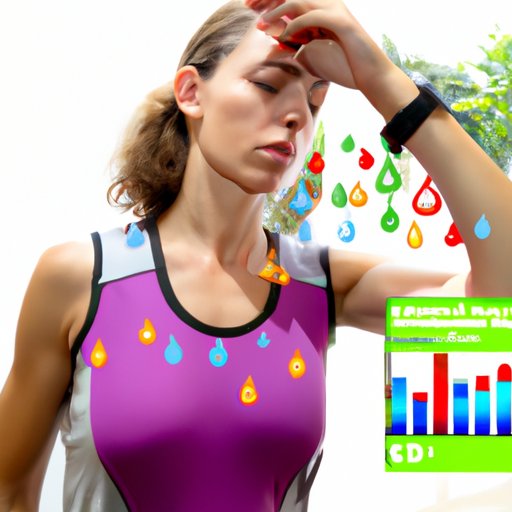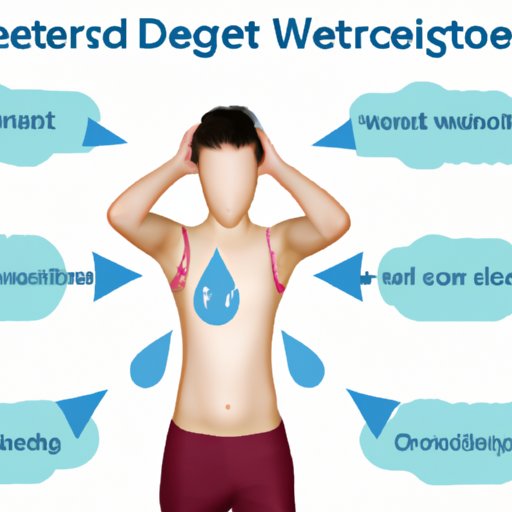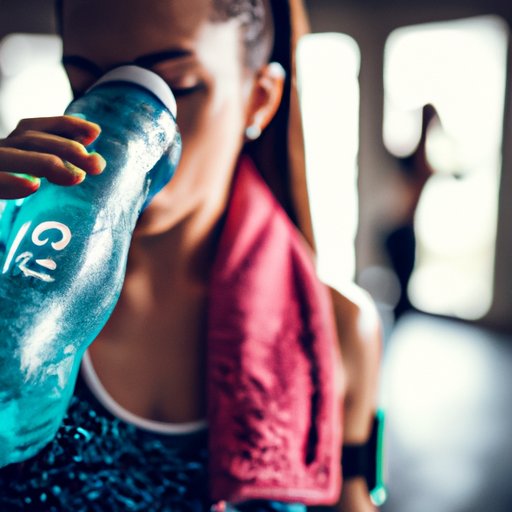Introduction
When it comes to working out, sweating is inevitable. But for some people, the amount of sweat produced during a workout can seem excessive. While this is not necessarily a sign of an underlying health issue, understanding why we sweat so much when we exercise can help us better manage our perspiration. In this article, we will explore the physiology of sweating, the benefits of sweat during exercise, the effects of heat and humidity on perspiration, the role of diet in sweat production, the causes of excessive sweating, and strategies for reducing sweat during workouts.
Examining the Physiology of Sweating
Sweating is the body’s natural way of regulating its temperature. It is controlled by two types of sweat glands located in the skin – eccrine glands and apocrine glands. Eccrine glands are widely distributed throughout the body and produce a clear, odorless sweat that helps regulate body temperature. Apocrine glands are found mainly in the armpits and groin and produce a thicker, more odorous sweat. This type of sweat is largely composed of proteins and fatty acids, which can be broken down by bacteria on the skin, leading to body odor.
In addition to sweat glands, hormones and neurotransmitters play a role in regulating sweat production. For example, the hormone epinephrine (also known as adrenaline) is released during exercise or in response to stress and increases sweat production. The neurotransmitter acetylcholine stimulates sweat glands, while endorphins inhibit them. Therefore, if you’re feeling relaxed and happy during your workout, you may find that you sweat less.
Exploring the Benefits of Sweat During Exercise
Sweating during exercise isn’t just a nuisance – it serves an important purpose. One benefit of sweat is its ability to detoxify the body. As sweat evaporates off the skin, it carries toxins such as heavy metals and chemicals with it, helping to reduce the body’s toxic load. Sweat also has a cooling effect, allowing the body to maintain a healthy temperature even during intense physical activity.
“Sweating is the body’s natural response to overheating,” says Dr. Jennifer Wider, a board-certified physician and women’s health expert. “It helps to cool the body down and prevent heat exhaustion, which can be dangerous in extreme cases.”

Analyzing the Effects of Heat and Humidity on Sweating
Heat and humidity can significantly increase sweat production, making it more difficult to stay cool during a workout. When exercising in hot and humid conditions, it’s important to take frequent breaks in order to prevent heat exhaustion or heat stroke. Drinking plenty of fluids, wearing light and breathable clothing, and taking a cool shower can all help to reduce sweat production.
Dr. Wider recommends wearing light colors, such as white or light blue, when exercising in hot and humid conditions. “Dark colors absorb heat, making it harder for the body to cool down,” she explains. “Light colors reflect the sun’s rays, helping to keep the body cool and reduce sweat production.”

Investigating the Role of Diet in Sweating
What you eat can also affect how much you sweat during exercise. Eating a healthy, balanced diet can help reduce sweat production, as certain foods may act as natural diuretics or stimulants that increase sweat production. Foods that contain caffeine, such as coffee, tea, and chocolate, can stimulate sweat glands and cause you to sweat more. Alcohol, spicy foods, and processed meats can also increase sweat production.
On the other hand, foods that are high in water content, such as fruits and vegetables, can help keep the body hydrated and reduce sweat production. Staying well hydrated before, during, and after exercise is essential for maintaining a healthy body temperature and preventing excessive sweating.

Understanding the Causes of Excessive Sweating
For some people, excessive sweating is caused by a medical condition such as hyperhidrosis, which is characterized by excessive sweating in areas such as the hands, feet, and face. Other medical conditions that can lead to excessive sweating include thyroid disorders, diabetes, anxiety, and menopause. It’s important to talk to your doctor if you suspect that you have a medical condition that is causing you to sweat excessively.
“If you think that you have a medical condition that is causing you to sweat excessively, it’s important to get it checked out by a doctor,” advises Dr. Wider. “Your doctor can diagnose the condition and recommend treatments that can help reduce your symptoms.”

Exploring Strategies to Reduce Sweat During Workouts
Even if you don’t have a medical condition that causes excessive sweating, there are still ways to reduce sweat production during exercise. Taking short breaks throughout your workout, drinking plenty of fluids, and choosing lighter activities such as walking or swimming can all help to reduce sweat production. Wearing lightweight, breathable clothing made from fabrics such as cotton and linen can also help keep the body cool and reduce sweat production.
Dr. Wider recommends avoiding fabrics such as polyester and nylon, which can trap heat and moisture against the skin and make it harder for the body to cool down. “Cotton and linen are much better choices for workout clothes because they allow air to circulate and wick away moisture,” she explains.
Evaluating the Impact of Clothing Choices on Sweating
Choosing the right clothing for your workout can make a big difference in reducing sweat production. Loose-fitting clothing allows air to circulate around the body and helps keep the body cool. Tight-fitting clothing, on the other hand, traps heat and moisture against the skin, making it harder for the body to cool down. If possible, opt for breathable fabrics such as cotton and linen, which are lightweight and allow air to circulate.
When choosing workout clothing, it’s also important to consider the fabric’s ability to wick away moisture. Fabrics such as polyester and spandex are good at wicking away moisture, but they can also trap heat and make it harder for the body to cool down. Natural fibers such as cotton and linen are better choices for wicking away moisture while still allowing air to circulate.
Conclusion
Sweating during exercise is a natural and beneficial response to physical activity and environmental conditions. Understanding the physiology of sweating, the benefits of sweat during exercise, the effects of heat and humidity on perspiration, the role of diet in sweat production, and the causes of excessive sweating can help us better manage our perspiration and stay cool during workouts. Additionally, choosing the right clothing and paying attention to our diet can help reduce sweat production during exercise.
For more information about sweating during exercise, consult your doctor or fitness professional for advice and tips on staying cool and dry during workouts.
(Note: Is this article not meeting your expectations? Do you have knowledge or insights to share? Unlock new opportunities and expand your reach by joining our authors team. Click Registration to join us and share your expertise with our readers.)
